Current events
Next talk tomorrow at 11:00 by Simone Sotgiu!
News 11.11.2025
New publication: Tailoring Phonon Polaritons in hBN with the Plasmonic Phase-Change Material In3SbTe2
Site Content:
08.03.2021
New publication: Tunable interdot coupling in few-electron bilayer graphene double quantum dots
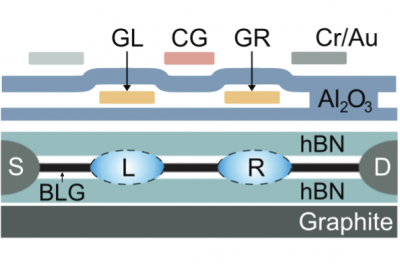
Appl. Phys. Lett. 118, 103101 (2021) We present a highly controllable double quantum dot device based on bilayer graphene. Using a device architecture of interdigitated gate fingers, we can control the interdot tunnel coupling between 1 and 4 GHz and the mutual capacitive coupling between 0.2 and 0.6 meV, independent of the charge occupation of the quantum dots. The charging energy and, hence, the dot size remain nearly unchanged. The tuning range of the tunnel coupling covers the operating regime of typical silicon and GaAs spin qubit devices.

05.03.2021
New publication: Dispersive sensing of charge states in a bilayer graphene quantum dot

Appl. Phys. Lett. 118, 093104 (2021) We demonstrate dispersive readout of individual charge states in a gate-defined few-electron quantum dot in bilayer graphene. We employ a radio frequency reflectometry circuit, where an LC resonator with a resonance frequency close to 280 MHz is directly coupled to an Ohmic contact of the quantum dot device. The detection scheme based on changes in the quantum capacitance operates over a wide gate-voltage range and allows us to probe excited states down to the single-electron regime. Crucially, the presented sensing technique avoids the use of an additional, capacitively coupled quantum device such as a quantum point contact or single electron transistor, making dispersive sensing particularly interesting for gate-defined graphene quantum dots.

16.02.2021
New publication: Pulsed-gate spectroscopy of single-electron spin states in bilayer graphene quantum dots

Phys. Rev. B 103, L081404 (2021) Graphene and bilayer graphene quantum dots are promising hosts for spin qubits with long coherence times. Although recent technological improvements make it possible to confine single electrons electrostatically in bilayer graphene quantum dots and their spin and valley texture of the single-particle spectrum has been studied in detail, their relaxation dynamics remains still unexplored. Here, we report on transport through a high-frequency gate-controlled single-electron bilayer graphene quantum dot. By transient current spectroscopy of single-electron spin states, we extract a lower bound of the spin relaxation time of 0.5 μs. This result represents an important step towards the investigation of spin coherence times in graphene-based quantum dots and the implementation of spin qubits.

28.01.2021
New publication: Tunable s-SNOM for Nanoscale Infrared Optical Measurement of Electronic Properties of Bilayer Graphene
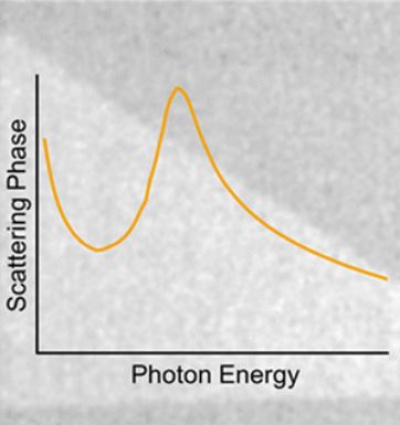
ACS Photonics 8, 418 (2021) Here we directly probe the electronic properties of bilayer graphene using s-SNOM measurements with a broadly tunable laser source over the energy range from 0.3 to 0.54 eV. We tune an OPO/OPA system around the interband resonance of Bernal stacked bilayer graphene (BLG) and extract amplitude and phase of the scattered light. This enables us to retrieve and reconstruct the complex optical conductivity resonance in BLG around 0.39 eV with nanoscale resolution. Our technique opens the door toward nanoscopic noncontact measurements of the electronic properties in complex hybrid 2D and van der Waals material systems, where scanning tunneling spectroscopy cannot access the decisive layers.

04.01.2021
Annika Kurzmann is joining our group
Dr. Annika Kurzmann is joining our group with a RWTH Junior Principal Investigator (JPI) fellowship.

05.11.2020
Sebastian is a Falling Walls Winner in the category Digital Education 2020
The nominating institution RWTH Aachen on the breakthrough:
With the free and open source app phyphox many sensors (even present in old and cheap smartphones) become accessible for students and turns their smartphones in mobile physics labs. Phyphox offers tools and instructions from school to university level and from individual labs with household items during Covid19 lockdown to global experiments to determine Earth’s axial tilt. The app, downloaded over 1.5 million and translated in 17 languages, makes science education worldwide more attractive.
For more information see here.
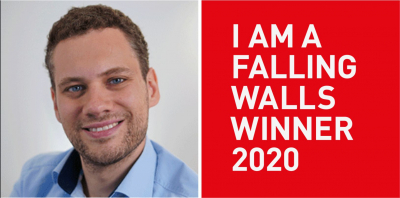

29.10.2020
New publication: Electron–Hole Crossover in Gate-Controlled Bilayer Graphene Quantum Dots
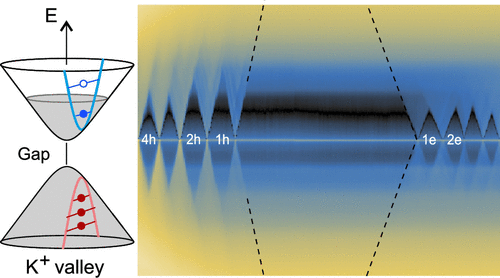
Nano Letters 20, 7709 (2020) Electron and hole Bloch states in bilayer graphene exhibit topological orbital magnetic moments with opposite signs, which allows for tunable valley-polarization in an out-of-plane magnetic field. This property makes electron and hole quantum dots (QDs) in bilayer graphene interesting for valley and spin-valley qubits. Here, we show measurements of the electron–hole crossover in a bilayer graphene QD, demonstrating opposite signs of the magnetic moments associated with the Berry curvature. Using three layers of top gates, we independently control the tunneling barriers while tuning the occupation from the few-hole regime to the few-electron regime, crossing the displacement-field-controlled band gap. The band gap is around 25 meV, while the charging energies of the electron and hole dots are between 3 and 5 meV. The extracted valley g-factor is around 17 and leads to opposite valley polarization for electrons and holes at moderate B-fields. Our measurements agree well with tight-binding calculations for our device.

10.09.2020
New publication: Fractional quantum Hall effect in CVD-grown graphene
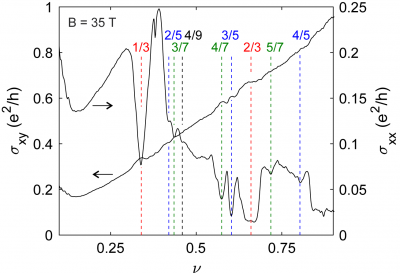
2D Materials 7, 041007 (2020) We show the emergence of fractional quantum Hall states in graphene grown by chemical vapor deposition (CVD) for magnetic fields from below 3 T to 35 T where the CVD-graphene was dry-transferred. Effective composite-fermion filling factors up to ν∗=4 are visible and higher order composite-fermion states (with four flux quanta attached) start to emerge at the highest fields. Our results show that the quantum mobility of CVD-grown graphene is comparable to that of exfoliated graphene and, more specifically, that the p/3 fractional quantum Hall states have energy gaps of up to 30 K, well comparable to those observed in other silicon-gated devices based on exfoliated graphene.

